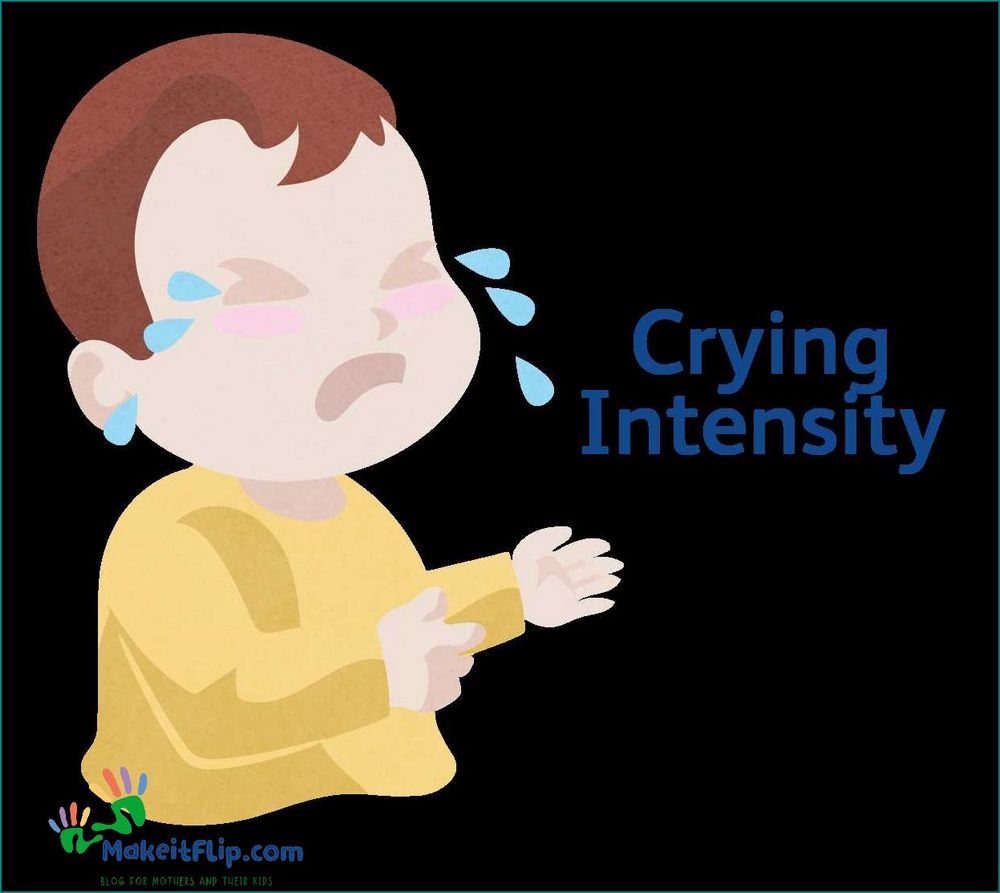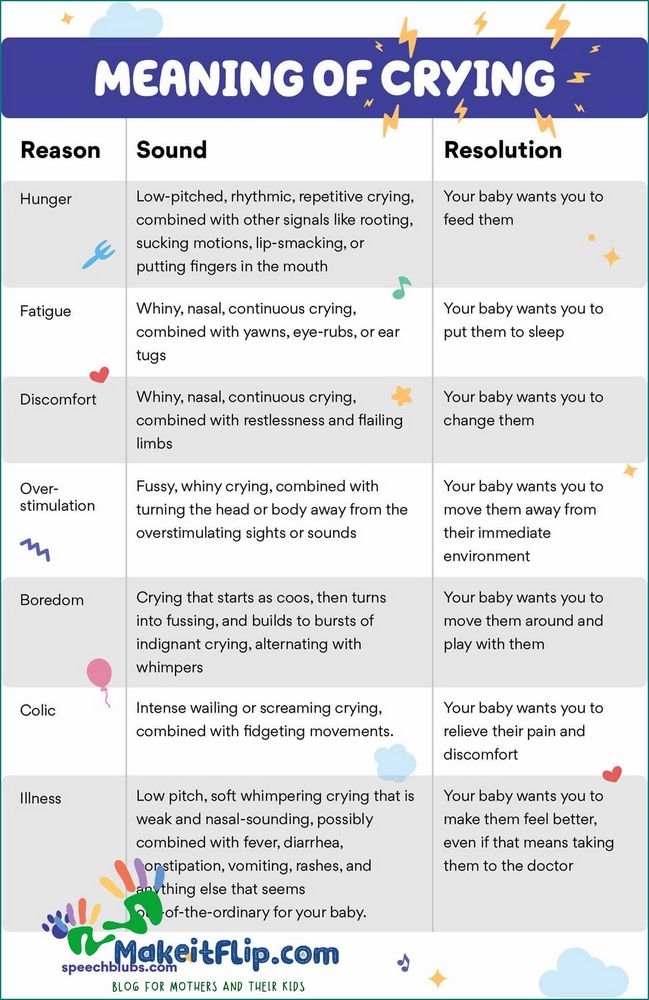Contents
Understanding the Various Types and Causes of Crying: A Comprehensive Guide to Crying Sounds

Crying is a natural human response to various emotions and situations. It is a sound that can take on different forms, such as wailing, whimpering, weeping, bawling, and more. Each type of crying sound carries its own unique meaning and can be caused by different factors.
Wailing is a loud and intense cry that is often associated with extreme pain or distress. It is a sound that can be heard from a distance and is usually accompanied by tears and a sense of desperation. Whimpering, on the other hand, is a softer and more subdued cry. It is often a sign of mild discomfort or sadness, and can be characterized by a trembling voice and intermittent pauses.
Weeping is a type of crying that is characterized by tears flowing freely and uncontrollably. It is often a response to deep sadness or grief, and can be accompanied by sobbing and a sense of loss. Bawling, on the other hand, is a loud and uncontrolled cry that is often associated with anger or frustration. It is a sound that can be heard from a distance and is usually accompanied by a red face and clenched fists.
Sniffling is a type of crying sound that is characterized by the sound of sniffing and wiping away tears. It is often a response to mild sadness or disappointment, and can be accompanied by a runny nose and a sense of vulnerability. Tears are a common element in all types of crying and are a physical manifestation of the emotions being experienced.
Understanding the different types and causes of crying can help us better understand and support those who are crying. It is important to remember that crying is a natural and healthy way for humans to express their emotions, and should be met with empathy and understanding.
Types of Crying

When it comes to crying, there are various types that individuals may experience. Each type is characterized by different sounds and expressions of emotions. Understanding these different types can help us better understand the underlying causes and emotions behind them.
Weeping: Weeping is a type of crying that is characterized by the presence of tears and a soft, gentle sound. It is often associated with sadness or grief and can be accompanied by a slight shaking of the body.
Bawling: Bawling is a more intense form of crying that is characterized by loud, uncontrollable sobs and wails. It is often associated with extreme distress, pain, or frustration.
Crying: Crying is a general term that encompasses a range of emotional expressions. It can include both weeping and bawling, as well as other forms of vocalization and tears.
Tears: Tears are a physical manifestation of crying and can be present in all types of crying. They are produced by the tear glands and are often associated with emotional release.
Sound: The sound of crying can vary depending on the individual and the intensity of their emotions. It can range from soft sniffles and whimpers to loud wails and sobs.
Wailing: Wailing is a type of crying that is characterized by loud, prolonged cries and a sense of desperation. It is often associated with intense grief or pain.
Sniffling: Sniffling is a type of crying that is characterized by repeated, quick inhalations through the nose. It is often associated with mild sadness or emotional discomfort.
Whimpering: Whimpering is a type of crying that is characterized by soft, plaintive sounds. It is often associated with feelings of vulnerability or fear.
By understanding the different types of crying, we can gain insight into the emotions and experiences of others. It is important to remember that crying is a natural and healthy way for individuals to express their emotions and seek comfort and support.
Infant Crying

Infant crying is a natural and common occurrence in babies. It is their way of communicating their needs and expressing their emotions. Crying can take on different forms and sounds, each with its own meaning and cause.
- Crying: This is the most common form of infant communication. It is characterized by a loud, intense sound and usually indicates that the baby is hungry, tired, uncomfortable, or in need of attention.
- Whimpering: This is a softer and quieter form of crying. It often indicates mild discomfort or dissatisfaction.
- Tears: Tears accompany crying and are a natural response to emotions such as sadness, frustration, or pain.
- Sound: The sound of an infant crying can vary in pitch, volume, and intensity, depending on the baby’s temperament and the cause of their distress.
- Wailing: This is a prolonged and intense form of crying. It may indicate extreme discomfort or distress.
- Weeping: Weeping is a form of crying that is often associated with sadness or emotional distress.
- Bawling: Bawling is a loud and uncontrollable form of crying. It can be a response to pain, fear, or frustration.
- Sniffling: Sniffling is the sound of a baby inhaling sharply through their nose while crying. It can indicate nasal congestion or discomfort.
Understanding the different types and causes of infant crying can help parents and caregivers respond appropriately and provide comfort and care to their babies.
Emotional Crying

Emotional crying is a natural response to intense emotions such as sadness, grief, joy, or frustration. It is characterized by the sound of tears falling and can vary in intensity and duration.
There are different types of emotional crying, each with its own distinct sound and expression. Weeping is a gentle form of crying, often accompanied by quiet sobs and a soft sound of tears falling. Wailing, on the other hand, is a more intense and loud cry, often accompanied by loud sobs and a wailing sound.
Sobbing is another form of emotional crying, characterized by deep, audible breaths and convulsive sobs. It is often accompanied by tears streaming down the face and a sound that is a combination of crying and gasping for air.
Whimpering is a softer form of crying, characterized by quiet, broken sobs and a whimpering sound. It is often associated with feelings of vulnerability or fear.
Sniffling is a common sound associated with emotional crying, as it is often accompanied by a runny nose. It is characterized by quick, short inhales through the nose and can be a sign of trying to suppress tears.
Bawling is a more intense form of emotional crying, characterized by loud, uncontrollable sobs and a loud crying sound. It is often associated with feelings of extreme sadness or frustration.
Overall, emotional crying is a complex and varied expression of human emotions. It can serve as a release of pent-up emotions and can provide a sense of relief and catharsis.
Painful Crying

Painful crying is characterized by intense and distressing sounds that indicate the presence of physical or emotional pain. This type of crying is often accompanied by wailing, a loud and prolonged sound that expresses extreme discomfort.
Individuals who are experiencing painful crying may also exhibit other sounds such as sniffling, whimpering, or bawling. Sniffling refers to the sound of someone trying to hold back tears, while whimpering is a soft and plaintive sound that conveys a sense of helplessness.
Bawling is a term used to describe loud and uncontrollable crying, often associated with infants or young children. It is characterized by open-mouthed crying and can be a sign of extreme distress or discomfort.
Weeping is another term used to describe painful crying. It is often accompanied by tears and can be a response to physical pain, emotional distress, or a combination of both.
Crying and sobbing are two terms that are often used interchangeably to describe painful crying. Crying refers to the act of shedding tears, while sobbing is characterized by loud and convulsive sounds that accompany the act of crying.
Painful crying can be caused by a variety of factors, including physical injuries, illness, emotional trauma, or intense feelings of sadness or grief. It is important to recognize and address the underlying cause of painful crying in order to provide appropriate support and comfort to the individual experiencing it.
Causes of Crying

Crying is a natural response to various emotions and stimuli. It can be triggered by a wide range of factors, including:
- Emotional distress: Strong feelings of sadness, anger, frustration, or fear can lead to crying.
- Physical pain: Crying can be a response to physical discomfort or injury.
- Stress: Overwhelming stress or anxiety can cause tears.
- Loss or grief: Crying is often associated with the loss of a loved one or experiencing grief.
- Relationship issues: Conflict, breakups, or feeling rejected can lead to crying.
- Frustration or disappointment: Crying can occur when expectations are not met or when faced with failure.
- Fatigue or exhaustion: Being tired or sleep-deprived can make a person more prone to crying.
- Empathy: Witnessing someone else’s pain or suffering can trigger tears.
Crying can manifest in different ways, including sniffling, tears streaming down the face, sobbing, whimpering, wailing, weeping, or bawling. The intensity and duration of crying can vary depending on the individual and the underlying cause.
Understanding the causes of crying can help individuals and those around them provide support and empathy during times of emotional distress.
Hunger

Hunger is one of the most common causes of crying in infants. When a baby is hungry, they may cry to communicate their need for food. The crying sound can vary from a soft whimpering to a loud wailing, and tears may accompany the crying. The baby may also display signs of distress, such as sucking on their fists or rooting for the breast.
It is important for parents and caregivers to recognize the signs of hunger crying and respond promptly to meet the baby’s needs. Feeding the baby can help soothe their hunger and provide comfort. Breastfeeding or bottle-feeding can help satisfy the baby’s hunger and promote bonding between the baby and caregiver.
It is also important to note that hunger crying can occur at any time, including during the night. Babies have small stomachs and need frequent feedings, especially in the early months. Responding to hunger crying promptly can help establish a healthy feeding routine and ensure the baby receives the nourishment they need.
If a baby continues to cry even after being fed, it is possible that there may be another underlying cause for their distress. It is important to consider other factors such as discomfort, tiredness, or illness. If the crying persists or is accompanied by other concerning symptoms, it is recommended to seek medical advice from a healthcare professional.
FAQ about topic Crying Sound Understanding the Different Types and Causes of Crying
Why do babies cry so much?
Babies cry as a way to communicate their needs and feelings. They may cry when they are hungry, tired, in pain, or need a diaper change. Crying is their way of getting attention and getting their needs met.
What are the different types of cries in babies?
Babies have different types of cries to express different needs. They may have a hunger cry, a tired cry, a pain cry, or a discomfort cry. Each cry has its own distinct sound and can help parents understand what their baby needs.
Can crying be a sign of a medical problem?
Yes, crying can sometimes be a sign of a medical problem. If a baby is crying excessively and inconsolably, it may be a sign of an underlying medical condition such as colic, acid reflux, or an ear infection. It’s important to consult a doctor if you are concerned about your baby’s crying.
How can I soothe a crying baby?
There are several ways to soothe a crying baby. You can try feeding them, changing their diaper, rocking them gently, singing or talking to them, or giving them a pacifier. Sometimes, simply holding and cuddling the baby can provide comfort and help them stop crying.
Is it normal for adults to cry?
Yes, it is normal for adults to cry. Crying is a natural emotional response to various situations and can help release stress and emotions. It is a healthy way to express sadness, grief, or other intense feelings. However, if someone is crying excessively or uncontrollably, it may be a sign of a deeper emotional issue and they may benefit from seeking professional help.
I’m Diana Ricciardi, the author behind Makeitflip.com. My blog is a dedicated space for mothers and their kids, where I share valuable insights, tips, and information to make parenting a bit easier and more enjoyable.
From finding the best booster seat high chair for your child, understanding the connection between sciatica and hip pain, to exploring the benefits of pooping in relieving acid reflux, I cover a range of topics that are essential for every parent.
My goal is to provide you with practical advice and solutions that you can easily incorporate into your daily life, ensuring that you and your child have the best possible experience during these precious years.
